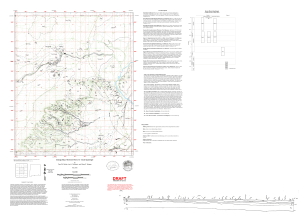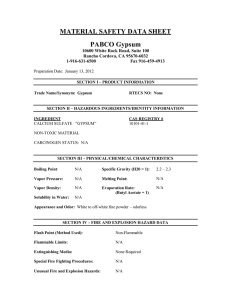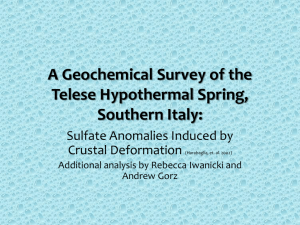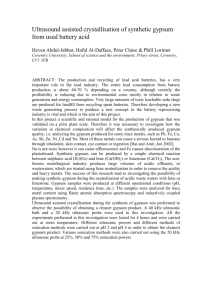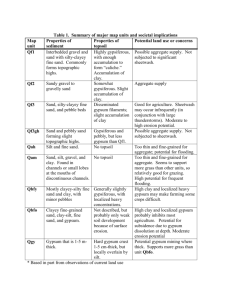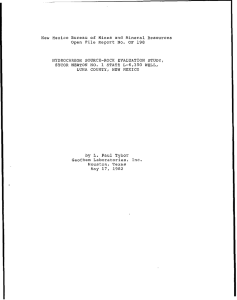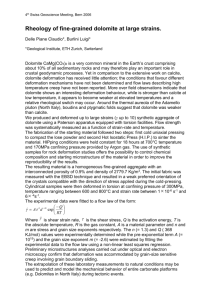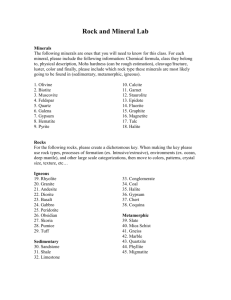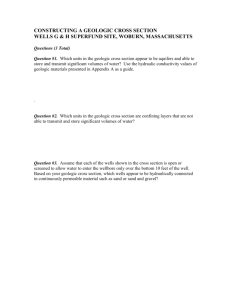Document 10993569
advertisement
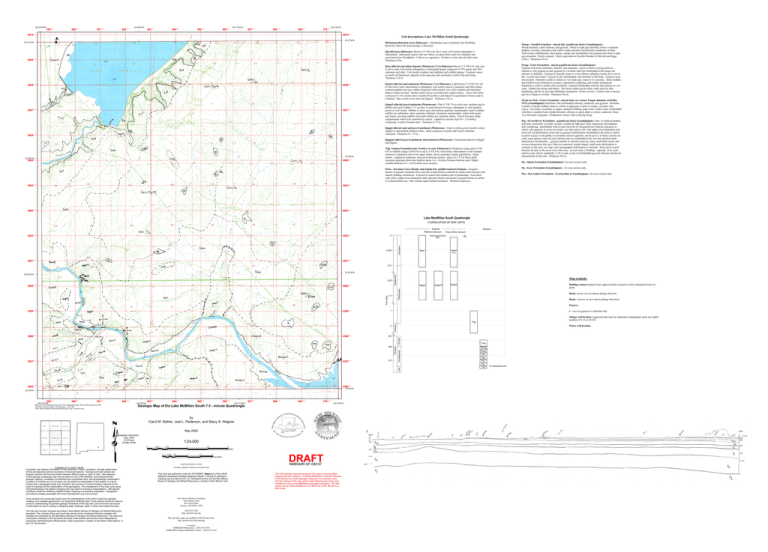
104°22'30"W 559000 560000 561000 562000 104°20'0"W 563000 564000 565000 566000 104°17'30"W 567000 568000 569000 570000 104°15'0"W 3610000 3610000 32°37'30"N 32°37'30"N 3609000 3609000 Unit descriptions, Lake McMillan South Quadrangle Hd-human disturbed areas (Holocene)— Disturbance area of drained Lake McMillan Reservior where the local geology is obscured. Ptmsg---Tansill Formation—mixed silty gypsiferous facies (Guadalupian)-Mixed dolomite, sandy siltstone, and gypsum. White to light gray dolomite, thinly to medium bedded, vesicular, associated with yellow sandy dolomite and dolomitic sandstones in float. Well sorted, sublitharenite, chert grains, orange-red, interbedded with gypsum and white to light gray dolomite. Poorly exposed. Likely equivalent to Ocotillo Member of DeFord and Riggs (1941). Thickness XX m. Qal-alluvium (Holocene)--Brown (7.5 YR 6/4), silt to sand, well sorted, subangular to subrounded, dominantly quartz with rare lithics, occupies draws and river channels and associated active floodplains. Little to no vegetation. Overlies or inset into all older units. Thickness 0-2m. Pymg---Yates Formation—mixed gypsiferous facies (Guadalupian)-Gypsum with minor dolomite, siltstone, and sandstone. green to white to red gypsiferous siltsone to silty gypsum to pure gypsum in 2-m-thick intervals interbedded with orange-red siltstone or dolomite. Gypsum is typically massive or has fibrous radiating crystals up to cms in dia. Locally brecciated. Gypsum is also interbedded with dolomite in thin beds. Gypsum veins also present. Dolomite is pink to salmon to very light gray, massive to vesicular, , thinly bedded, and exhibits local chickenwire textures, rippenstein weathering, and crinkly laminations. Sandstone is yellow, locally silica cemented. Gypsum interbedded with dol and siltsone on a mscale. Folded into domes and basins. This facies makes up the strike valley and low hills paralleling, and SE of, the Lake McMillan escarpment. Forms caverns. Contact with overlying gravels is sharp or covered. Thickness XX m. Qaes-alluvial and eolian deposits (Pleistocene (?) to Holocene)-Brown (7.5 YR 6/4), silty clay to silt to sand, well sorted, subangular to subrounded grains composed of 70% quartz and 30% carbonate and chert. Unit locally weathers into badlands and exhibits piping. Common veneer on nearly all Quaternary deposits in the map area and commonly overlies Psg and Pymg. Thickness ≤10 m. 3608000 3608000 3607000 3607000 3606000 3606000 Qasm1-alluvial sand mainstem (Pleistocene (?) to Holocene)- Light brown (7.5 YR 6/4), silt to fine-lower sand, subrounded to subangular, well sorted, massive, quartzose and lithic grains, scattered pebbles and rare cobbles dispersed within matrix, rare calcic nodules and laminated drapes of dark red mud. Surface nearly always reworked into coppice dunes. Top of unit forms a terraces(T1) five meters above modern Pecos River and deposit is equivalent to flume sand in Carlsbad. May overlie or be inset into Qagm2. Thickness ≤10 m. (Pyms or) Psd---(Yates Formation—mixed facies or) Azotea Tongue dolomite (of Kelley 1971) (Guadalupian)--Dolomite with interbedded siltstone, sandstone, and gypsum. Dolomite is thinly to thickly bedded, massive, yellow to light gray to pink to orange, vesicular, silty, clayey, very finely crystalline to sugary, undulose bedding, paper lams, crinkly lams, interbedded with thin to medium beds of pink dolomitic siltstone or green shale or yellow sandstone. Some very thin beds of gypsum. Gradational contact with overlying Pymg. Qagm2-alluvial gravel mainstem (Pleiostocene) Pink (5 YR 7/4) to red to tan, medium sand to pebble and small cobbles (<12 cm dia.) in sand and gravel lenses, subangular to well rounded, poorly to well sorted. Pebbles of chert, gray and maroon quartzite, metamorphic clast(?),smaller cobbles are carbonates, chert, quartzite, dolomite, limestone, metamorphic, schist, bull quartz, and basalt, and large pebbles and small cobbles are carbonate lithics. Gravel becomes sandy conglomerate where well cemented by calcite. Capped by calcrete layer (0-< 2 m thick). Commonly overlies Permian units. Thickness 0-75 m. Psg---Seven Rivers Formation—gypsiferous facies (Guadalupian)---thin- to medium-bedded, dolomite, commonly vesicular, tan-grey weathered, light grey fresh, rippenstein and elephant skin weathering, interbedded with m-scale intervals of red gypsiferous siltstone and green to yellow silty gypsum, in cycles (m-scale), very fine sand to silt, with ripple-cross lamination and local soft sed deformation (some due to gypsum mobilization) interbedded with white to yellow to green to gray to red, punky to crystalline massive gypsum, can be up to 2 m thick, crystals cm scale, some gypsum intervals lack siltstone and are interbedded with very thin dolomite beds, laminated to stromatolitic, gypsum nodules in siltstone intervals, many small folds (scale) and caverns characterize this unit, folds are commonly trough shaped, small-scale deformation is common in this unit, yet, large scale stratographic deformation is minimal—beds can be traced laterally for kms in the seven rivers hills area, several scales of folding—mpscale, 10-m scale, and km scale, all low amplitude, 5-10 m scale cycles of interbedded gyp and siltstone and dol are characteristic of this unit. Thickness XX m. Qagp2-alluvial sand and gravel piedmont (Pleistocene) Gray to yellow gravel, poorly sorted, angular to subrounded dolomite clasts. Sand composed of quartz and locally carbonate cemented. Thickness 0->~75 m. Qagpm2-alluvial gravel piedmont and mainstem (Pleistocene) Transitional deposit of Qagp2 and Qagm2. 32°35'0"N 32°35'0"N 3605000 3605000 TQg Gatuna Formation (late Tertiary to early Pleistocene?) Moderate orange pink (5 YR 8/4) to reddish orange (10 R 6/6) to red (2.5 YR 5/6), well sorted, subrounded to well rounded siltstone to sandstone (silt to fine upper sand), calcite cemented, locally gypsiferous. Slope former. Capped by mudstone- and gravel-bearing calcrete: plug is 0.5-1.0 m thick, pillar structures penetrate down into bedrock about 2 m. Overlies Permian bedrock units. Highly variable thickness 0->~130 m (from cross section). Pq—Queen Formation (Guadalupian)-- In cross section only. Pg—Gray Formation (Guadalupian)— In cross section only. Prlsu—Permian Lower Rustler and Salado Fm, undifferentiated (Ochoan) - Irregular masses of gypsum, dolomite (Prc), and salt in large blocks scattered on surface and outcrops with chaotic bedding orientations. Exposed in eastern and southern part of quadrangle. Associated with yellow ripple-cross-laminated sandy dolomite blocks and massive gypsum blocks at surface in Gypsum Bend area. May include upper Salado Formation. Thickness unknown. 3604000 3604000 3603000 3603000 Psa—San Andres Formation—(Leonardian to Guadalupian)—In cross section only. Lake MacMillan South Quadrangle CORRELATION OF MAP UNITS Surficial Piedmont alluvium 3602000 0 0.005 3601000 Pecos River alluvium Hd Qal Holocene 3602000 Bedrock Qasm1 (T1) Qaes 3601000 0.01 3600000 Time (Ma) 3600000 3599000 3599000 Map symbols: Qags2 Qagpm2 Bedding contact-dashed where approximately located or where interpreted from air photo Qagm2 Pleistocene 0.05 Quaternary 32°32'30"N 32°32'30"N 0.1 Basin- arrows on axis denote plunge direction Dome—arrows on axes denote plunge directions Fissure-c—cave in gypsum or carbonate unit 1 Oil/gas well location (suggested type logs for subsurface stratigraphic picks are logfile numbers 47113 or 24319) 251 260 3597000 271 3596000 3596000 32°30'0"N 32°30'0"N 559000 560000 104°22'30"W 561000 562000 104°20'0"W 563000 564000 565000 566000 104°17'30"W 567000 568000 569000 570000 Geologic Map of the Lake McMillan South 7.5 - minute Quadrangle Base from U.S.Geological Survey 1955, from photographs taken 1947 and field checked in 1955. 1927 North American datum, UTM projection -- zone 13N 1000- meter Universal Transverse Mercator grid, zone 13, shown in red 104°15'0"W by Carol M. Delher, Joel L. Pederson, and Stacy S. Wagner Dayton Lake Mcmillan North Illinois Camp May 2005 Seven Rivers Lake Mcmillan South Angel Draw Magnetic Declination May, 2005 8º 39' East At Map Center 1:24,000 0 Azotea Peak Carlsbad West 0.25 0.5 1 1.5 2 Miles Carlsbad East 0 0.25 0.5 1 1.5 2 Kilometers CONTOUR INTERVAL 10 FEET COMMENTS TO MAP USERS A geologic map displays information on the distribution, nature, orientation, and age relationships of rock and deposits and the occurrence of structural features. Geologic and fault contacts are irregular surfaces that form boundaries between different types or ages of units. Data depicted on this geologic quadrangle map may be based on any of the following: reconnaissance field geologic mapping, compilation of published and unpublished work, and photogeologic interpretation. Locations of contacts are not surveyed, but are plotted by interpretation of the position of a given contact onto a topographic base map; therefore, the accuracy of contact locations depends on the scale of mapping and the interpretation of the geologist(s). Any enlargement of this map could cause misunderstanding in the detail of mapping and may result in erroneous interpretations. Site-specific conditions should be verified by detailed surface mapping or subsurface exploration. Topographic and cultural changes associated with recent development may not be shown. DRAFT NMBGMR OF-GM 97 NATIONAL GEODETIC VERTICAL DATUM OF 1929 This work was performed under the STATEMAP component of the USGS Text National Cooperative Geologic Mapping Program. Funding for geological mapping was provided by the U.S. Geological Survey and the New Mexico Bureau of Geology and Mineral Resources, a division of New Mexico Tech. Cross sections are constructed based upon the interpretations of the author made from geologic mapping, and available geophysical, and subsurface (drillhole) data. Cross-sections should be used as an aid to understanding the general geologic framework of the map area, and not be the sole source of information for use in locating or designing wells, buildings, roads, or other man-made structures. New Mexico Bureau of Geology New Mexico Tech 801 Leroy Place Socorro, NM 87801-4796 The map has not been reviewed according to New Mexico Bureau of Geology and Mineral Resources standards. The contents of the report and map should not be considered final and complete until reviewed and published by the New Mexico Bureau of Geology and Mineral Resources. The views and conclusions contained in this document are those of the authors and should not be interpreted as necessarily representing the official policies, either expressed or implied, of the State of New Mexico, or the U.S. Government. [505] 835-5420 http://geoinfo.nmt.edu This and other maps are available in PDF format from: http://geoinfo.nmt.edu/statemap or contact: NMBGMR Publications -- [505] 835-5410 NMBGMR Geologic Information Center -- [505] 835-5145 This draft geologic map was produced from scans of hand-drafted originals from the author(s). It is being distributed in this form because of the demand for current geologic mapping in this important area. The final release of this map will be made following peer review and redrafting in color using NMBGMR cartographic standards. The final product will be made available on the internet as a PDF file and in a GIS format. Prlsu Ptmsg Leo. 3597000 Ochoan 3598000 Permian 3598000 Water well location Guadalupian 2 Tertiary TQg Pymg Psd Psg Pq* Pg* Psa* *In subsurface only
